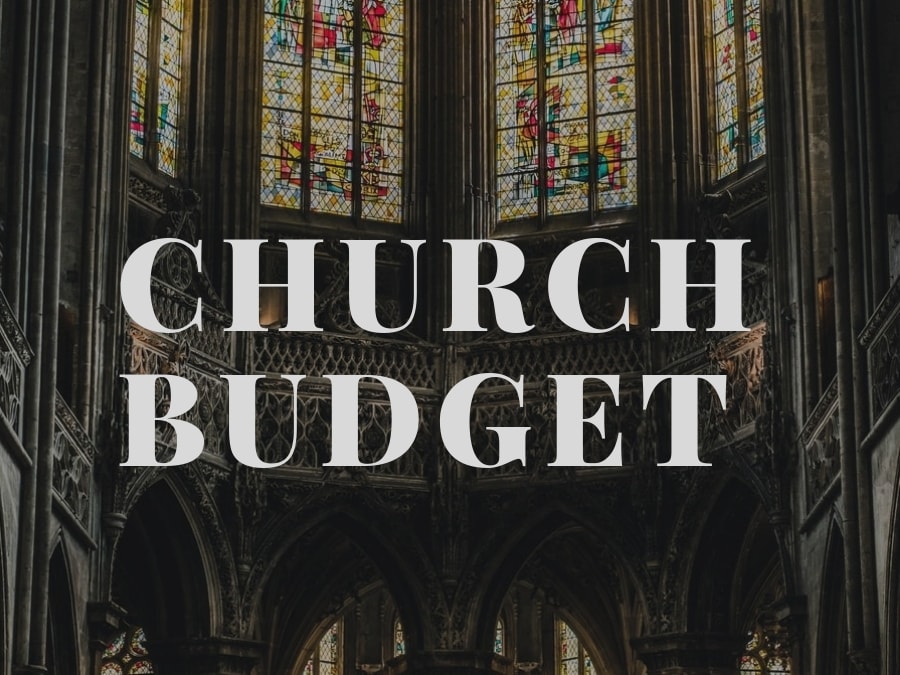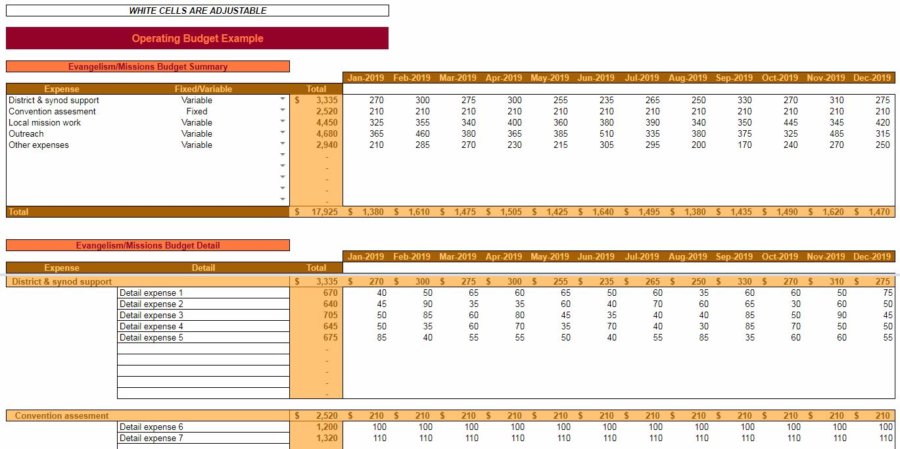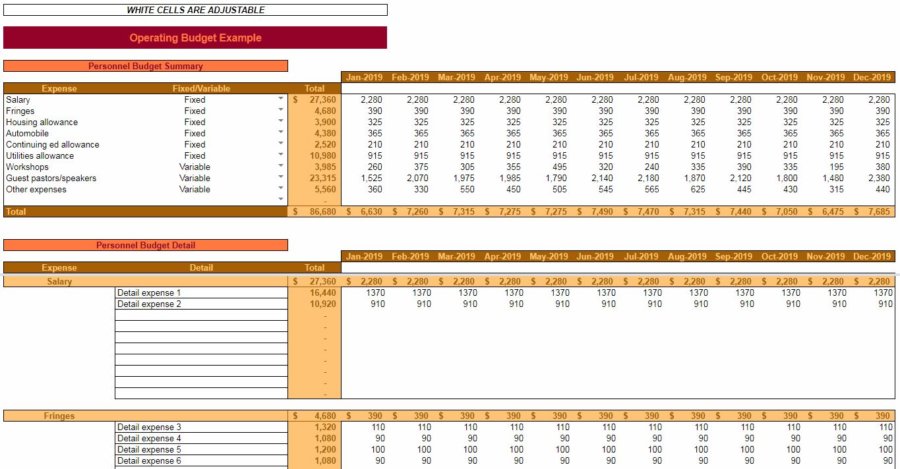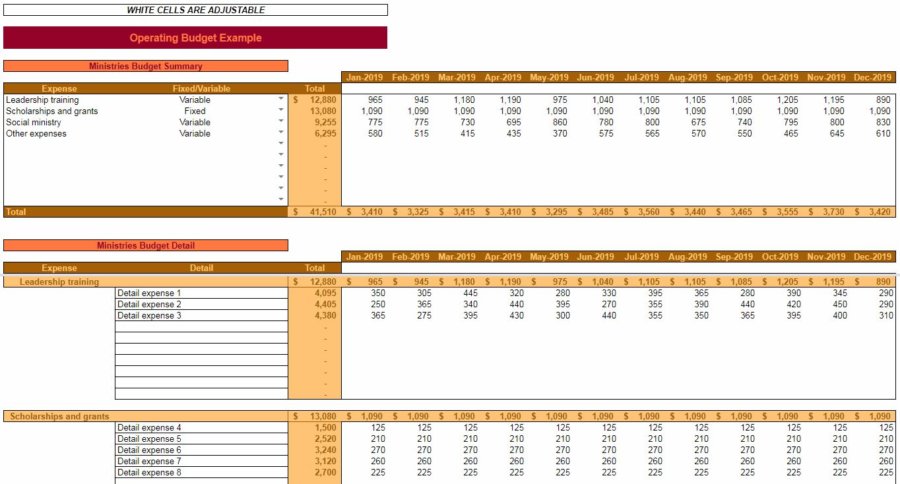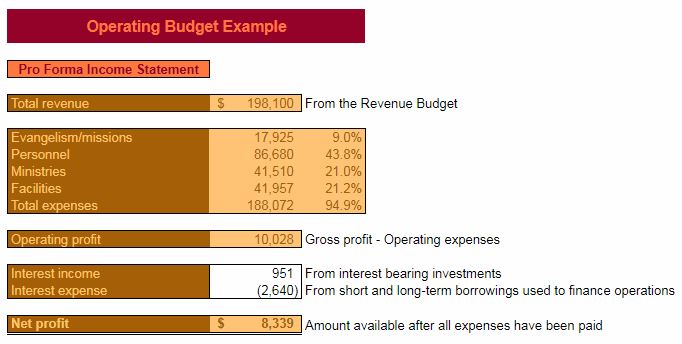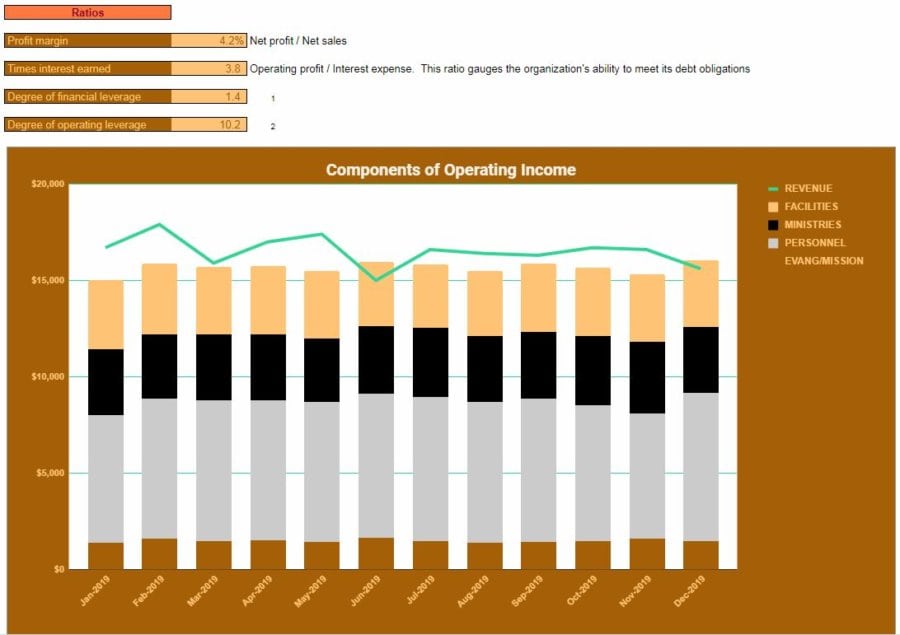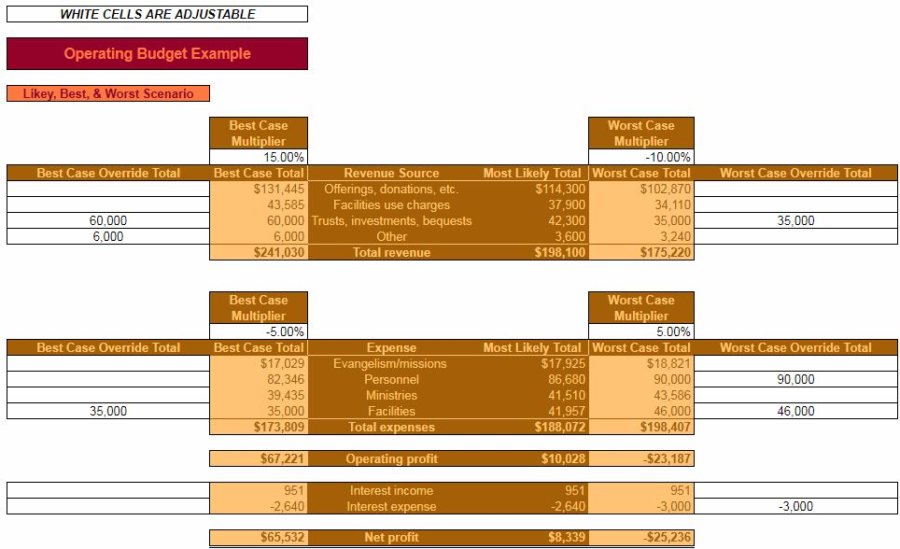Video Transcript
00:00 I’m gonna go over how to go about making
00:04 operating budget for your church some of
00:06 my previous videos you know I’ve done a
00:08 little more in depth with the individual
00:10 spreadsheets and how you know what each
00:12 field is about how its calculating
00:14 everything this time I’m going to try
00:16 something different I’m gonna stick to
00:18 kind of summarizing here and I’m gonna
00:19 put a link down in the description where
00:21 you can read the whole in-depth post
00:24 that covers every single aspect you know
00:27 in detail of the operating budget for
00:30 your church and the video here is just
00:32 gonna be kind of a summary so that being
00:34 said let’s get into it
00:36 we’ll start off here with a ordinarily
00:41 with a for-profit company you always
00:44 start with a revenue budget with the
00:45 church you have a little flexibility
00:47 there you start with a revenue budget or
00:48 with your expense budget so for the sake
00:52 of simplicity I’m going to walk through
00:54 this starting with the revenue budget
00:55 but you know it really is a matter of
00:59 private preference do to kind of
01:01 churches unique situations so revenue
01:04 budget is exactly what it sounds like
01:06 it’s a budget in a forecast for all of
01:08 the money you’re gonna bring in for the
01:10 year so in this case we’ve got the
01:13 different sources listed here offerings
01:15 donations facility whose charges trust
01:18 investments and other okay and we reject
01:21 them out for every month for the coming
01:23 year but the first month of our planning
01:25 period here so if you’re planning
01:27 creative begins in July or September or
01:29 whatever some other month with that in
01:32 there it’ll automatically populate it
01:33 out and all the forecasted amounts are
01:38 total by month and total by source also
01:42 point out real quick that all
01:44 spreadsheets for business templates
01:46 which there’ll be a link to the template
01:49 in the link to the post so you get that
01:53 by going to the post but all
01:56 spreadsheets for business workbooks the
02:00 white cells are adjustable okay the
02:02 colored in cells or other formulas or
02:03 their text so unless you really really
02:05 know what you’re doing don’t touch those
02:07 so revenue budget is pretty simple and
02:11 we’ll move on to the expense budgets now
02:16 let me get rid of the fixed cells here
02:21 there’s separate expense budgets for
02:25 each of the four kind of broad
02:26 categories of expenses the inspiration
02:29 for these categories comes from Bree mal
02:31 FERS if you’ve done any searching on
02:33 YouTube or on the web in regards to
02:36 Church strategic planning you’ve come
02:37 across
02:38 Audrey’s work and he’s does a great job
02:42 and you know definitely a good source of
02:47 information I’ve never seen him put
02:48 forth anything like this not to say that
02:50 he hasn’t that I used a lot of his
02:54 inspiration in creating this template
02:57 for budgeting so now he breaks it church
03:02 expenses into four broad categories
03:04 evangelism emissions personnel
03:06 ministries and facilities so as you can
03:09 sing along the bottom here that’s
03:10 exactly what we’ve done
03:12 each of these four budgets is formatted
03:15 in the same manner so for simplicity
03:17 sake we’ll just look at the evangelism
03:21 and missions budget here so what you got
03:26 at the top here is you know basically
03:29 when it would take those broad
03:30 categories expenses and break them down
03:31 into subcategories so do that first and
03:35 foremost for the evangelism missions
03:36 here and direct and Synod support
03:39 Convention Assessment local mission work
03:40 outreach etc of course each broad
03:44 category has its own separate sub
03:48 categories you came and you’ll notice
03:52 also you’ll have to fill those in
03:54 manually and also you’ll notice that
03:56 each bra subcategory of expenses gets
04:03 category wrap categorized as fixed or
04:06 variable and simply put the post goes in
04:11 a little more detail but you know fixed
04:14 is gonna be the same no matter your
04:16 level of revenue a more revenue less
04:19 revenue you would expect this expense to
04:21 stay the same
04:22 variable on the other hand you would
04:24 expect to increase with revenue and
04:25 decrease increase in decrease with
04:28 revenue less revenue less expense more
04:29 revenue more expense okay so you’ll see
04:32 that all these amounts are filled in
04:34 here a lot of them with zeros because
04:36 there’s a room for plenty of
04:38 subcategories well where’s that
04:39 information come it comes from down here
04:41 below this is where you get into the
04:42 detail okay so you’ll notice each sub
04:45 categories listed here and you can
04:47 detail expenses and this is where you
04:48 actually put in the inmense so you know
04:51 you take a broad category of expenses
04:53 break it down to subcategories break it
04:55 down further into details you know
04:58 depending on the sophistication of your
05:00 accounting software or your accountant
05:04 you know this could be these detailed
05:06 expenses here could be individual GL
05:08 accounts or whatever you want them to be
05:11 but as long as you address all expenses
05:14 that’s all that really matters it’s just
05:16 like I said kind of breaking things down
05:18 here into manageable chunks to where you
05:22 can forecast them out for every month in
05:26 the planning period then they’ll total
05:29 here and those totals will carry up here
05:32 okay so you’ll see like I said every
05:36 subcategory of expenses listed here with
05:39 plenty of room to entered detailed
05:42 expenses okay so you do that for
05:45 evangelism and admission you do that for
05:50 personnel do it for ministries it’s all
05:55 them all the same same format do it for
05:58 facilities so okay you better you expect
06:01 the revenue for the year then you
06:03 entered your expected expenses for the
06:07 year don’t forget like in this example
06:09 real quick here you’ll notice this ties
06:13 into the capital budgeting work that we
06:18 did – I like to make my workbooks tie
06:22 into each other so it can paint the
06:24 entire picture for you guys so that’s
06:26 what this means you know most of these
06:28 are Justin Eric detailed expenses but
06:30 this one here talks about snow removal
06:32 and it has to do with the
06:34 creation of a new parking lot that we
06:36 looked at in the capital budget so check
06:38 that video out to check that post out to
06:41 so and yeah once all expenses are
06:46 entered then that’s the biggest part of
06:51 budgeting okay all that’s going to carry
06:54 over here into your pro forma income
06:56 statement where you’ve got your total
06:58 revenue your total for each expense by
07:02 broad category okay and then we threw in
07:05 a percentage amount here
07:08 that’s a percentage of revenue if I
07:11 remember right yes it is okay just just
07:15 kind of paint the picture of what
07:18 categories are contributing most to your
07:20 expenses then we’ve got operating profit
07:23 which is revenue minus expenses one
07:27 other thing you have to fill in I mean
07:28 pro forma income statement here that
07:30 isn’t really covered elsewhere in the
07:31 operating budget is interest income in
07:35 interest expense okay so this is a will
07:39 have to be a forecast you’ll just have
07:41 to look at you know for income if you
07:44 have income earning assets savings you
07:49 know money market accounts something
07:52 that maybe earns a little more than that
07:54 dividends perhaps enter now here
07:57 interest expense it’s gonna depend in
07:58 large part on the amount you need to
08:00 borrow a lot of that will be covered in
08:02 the financial budget okay but you know
08:05 you can go ahead and do your financial
08:08 budget which I’ll cover in a later video
08:09 and a post that’s coming soon and circle
08:13 back around enter that information here
08:14 too okay you’re not gonna be graded on
08:18 your accuracy in terms of forecasting
08:20 this can be a living document come back
08:21 and change it as you need to
08:23 all right so operating profit minus
08:25 these interest expenses churches don’t
08:27 pay taxes so there’s net profit okay
08:32 there’s a couple of simple ratios left
08:34 in here that are applicable for churches
08:38 okay got profit margin which is pretty
08:39 self-explanatory you know your net
08:42 profit compared to you net sales times
08:44 interest earned looks at those
08:46 looks at interest expense and operating
08:50 profit how it relates to it degree of
08:53 financial leverage again the post will
08:54 get into more detail in degree of
08:56 operating leverage we’ll get more detail
08:58 on that too those are two interesting
09:00 concepts that basically tell you what
09:07 the based on degree of financial
09:10 leverage based on the amount of money
09:14 you borrow what effect increasing and
09:20 decreasing
09:21 operating profit would have on that or
09:25 the rather the effect you’ll have to
09:29 read the posts to get a detail because
09:30 if I start talking about it I’ll go on
09:32 for an hour here and like I said and try
09:34 to make this summary so basically the
09:39 effect of degree of financial leverage
09:41 is the effect of interest expense on
09:45 profit degree of operating leverage is
09:47 the effect of fixed expenses fixed costs
09:52 on profit okay and that’s why I asked
09:56 you guys to specify whether costs are
09:59 fixed or variable here okay so that’s
10:01 what that was for read more about that
10:03 like I said you’ve got the chart down
10:06 here pretty straightforward just an
10:08 illustration of what happens month by
10:10 month based off of your forecast you’ve
10:12 got the Green Line is revenue and then
10:15 you’ve got your different categories of
10:16 expenses here you can see how they rise
10:18 and fall in total and by categories so
10:22 one little extra bonus that I like to
10:26 add to my industry specific spreadsheets
10:29 is this likely best case worst case
10:33 scenario okay I think this is super
10:36 valuable you know and it’s it is another
10:39 step and the whole strategic planning
10:43 thing which is time-consuming in that
10:44 bed really is just the like I said the
10:50 plus one however you want to put it to
10:53 to the operating budget this is where
10:56 you know you’ve done you’ve been in put
10:58 your
10:59 expected revenue cost profit etc now you
11:02 get to toy with what the worst case
11:04 would be in the best case would be and
11:06 this just like most of strategic
11:08 planning
11:09 just get your mind working in that
11:10 direction so you’re you’re completely
11:14 comprehensively prepared for the
11:15 upcoming year okay so it starts off here
11:19 with the pro forma income statement
11:26 that’s what this is sure if it Proform
11:28 in there but yeah it’s a pro forma
11:31 income statement or rather this yeah
11:35 sorry okay so this is revenue up here
11:37 where you can toy with best cased amount
11:40 for each revenue source
11:45 worst case amount or you can just use a
11:48 generic multiplier okay so basically
11:52 what that means it’s like if I change
11:53 this worst case is gonna be negative in
11:55 the case of revenue the 15% you’re gonna
11:59 see these worst case amounts decrease
12:03 okay because I made the worst excuse me
12:08 in the worst case that much worse
12:10 okay but you have so you can change that
12:15 there it will affect everything in that
12:17 section but you also have the ability to
12:20 override it okay so see if we delete
12:25 this worst case would be 38,000 versus
12:31 42,000 for trust investments in the
12:34 quest but you know say you think no no
12:38 worst case could be worse than that or
12:40 worst case wouldn’t be quite as bad well
12:43 then you just override that amount okay
12:46 everything else is based off of this
12:48 multiplier but now you’ve overwritten it
12:51 with an amount so same same principle in
12:55 the best case I’d come down here to
12:58 expenses we have our abroad expense
13:00 categories again use a multiplier this
13:04 is just a ballpark figure the multiplier
13:06 basically if you know best-case in the
13:10 Fuhrer expects is going to be the
13:11 decrease
13:12 worst case for expenses gonna be the day
13:15 increase and I keep doing it
13:17 so keep that in mind and you can
13:20 override you don’t like what you see so
13:22 yeah just toy with it you know that’s
13:25 the whole point of this exercise just
13:28 toy with it see what playing with
13:32 different scenarios gives you what it
13:35 makes you think about what you might do
13:37 to plan to avoid a worst case what you
13:39 what planning you might do to take
13:41 advantage of the best case okay so just
13:44 like the pro forma income statement on
13:45 this executive summary
13:47 you got your operating profit here you
13:50 can see negative under worst case this
13:54 will match what’s on the executive
13:55 summary the ten thousand twenty eight
13:58 operating profit and best case
14:05 considerably better six times the
14:07 operating profit so that’s pretty good
14:10 it brings in interest income and expense
14:14 here also and then that profit always
14:20 calculated the exact same as it is on
14:21 the executive summary so then of course
14:25 the you know the whole purpose of ratios
14:26 is to kind of put amounts into
14:31 perspective from your financial
14:34 statements and the same thing takes
14:36 place here you know profit margin can
14:38 range from negative seventeen point
14:41 eight to twenty seven positive twenty
14:43 seven point two times interest earned
14:45 degree of financial leverage is going to
14:48 change all that it’s gonna going to
14:50 change based off of what you enter in
14:52 the best case in worst case fields above
14:57 some anyhow that’s quick rundown of the
15:01 church operating budget template you
15:04 know go get your own copy to toy with I
15:06 get his follow the link and there’ll be
15:10 a links on there follow a link to the
15:13 post there’ll be links on there to
15:14 download your own copy of it and then
15:16 you know you if you’re dealing with
15:18 concepts you’re not familiar with just
15:20 check out the post I’ve got more or less
15:22 every single field on here
15:24 addressed in there and you know if you
15:28 get stuck on something just check that
15:30 out and it’ll help you make sense what
15:33 you’re looking at so appreciate you
15:35 guys’s time appreciate you watching this
15:39 video if you have until this point the
15:41 very end YouTube it is a popularity
15:45 contest just like anything on the
15:47 Internet and if you like this video if
15:50 you think this seems like something
15:51 useful to you best way to let me know is
15:55 to either leave a comment down below or
16:00 better yet maybe I don’t know depends on
16:03 the YouTube algorithm comments are good
16:06 likes or good subscriptions are good I
16:08 know
16:10 alerts are good any of that stuff you
16:13 know I’ll feedbacks good I’ll crank out
16:16 more content there’s also a lot of stuff
16:19 to check out not just for churches but
16:22 for small businesses in general on
16:23 spreadsheets for business comm thanks
16:26 you guys take care


